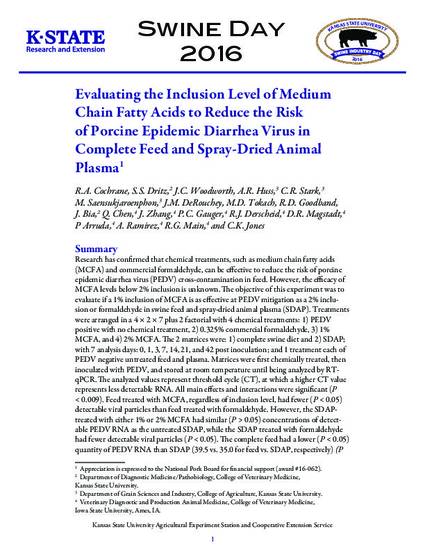
- PEDV,
- medium chain fatty acids,
- feed matrix,
- swine
Research has confirmed that chemical treatments, such as medium chain fatty acids (MCFA) and commercial formaldehyde, can be effective to reduce the risk of porcine epidemic diarrhea virus (PEDV) cross-contamination in feed. However, the efficacy of MCFA levels below 2% inclusion is unknown. The objective of this experiment was to evaluate if a 1% inclusion of MCFA is as effective at PEDV mitigation as a 2% inclusion or formaldehyde in swine feed and spray-dried animal plasma (SDAP). Treatments were arranged in a 4 × 2 × 7 plus 2 factorial with 4 chemical treatments: 1) PEDV positive with no chemical treatment, 2) 0.325% commercial formaldehyde, 3) 1% MCFA, and 4) 2% MCFA. The 2 matrices were: 1) complete swine diet and 2) SDAP; with 7 analysis days: 0, 1, 3, 7, 14, 21, and 42 post inoculation; and 1 treatment each of PEDV negative untreated feed and plasma. Matrices were first chemically treated, then inoculated with PEDV, and stored at room temperature until being analyzed by RTqPCR. The analyzed values represent threshold cycle (CT), at which a higher CT value represents less detectable RNA. All main effects and interactions were significant (P<0.009). Feed treated with MCFA, regardless of inclusion level, had fewer (P<0.05) detectable viral particles than feed treated with formaldehyde. However, the SDAPtreated with either 1% or 2% MCFA had similar (P>0.05) concentrations of detectable PEDV RNA as the untreated SDAP, while the SDAP treated with formaldehyde had fewer detectable viral particles (P<0.05). The complete feed had a lower (P<0.05) quantity of PEDV RNA than SDAP (39.5 vs. 35.0 for feed vs. SDAP, respectively) (P<0.05). Analysis day also decreased (P<0.05) the quantity of detectable viral particles from d 0 to 42, (33.2 vs. 44.0, respectively). In summary, time, formaldehyde, and MCFA all appear to enhance RNA degradation of PEDV in swine feed and ingredients; however, their effectiveness varies within matrix. The 1% inclusion level of MCFA was as effective as 2% in complete feed, but neither were effective at reducing the magnitude of PEDV RNA in SDAP.
Available at: http://works.bepress.com/alejandro_ramirez/44/
